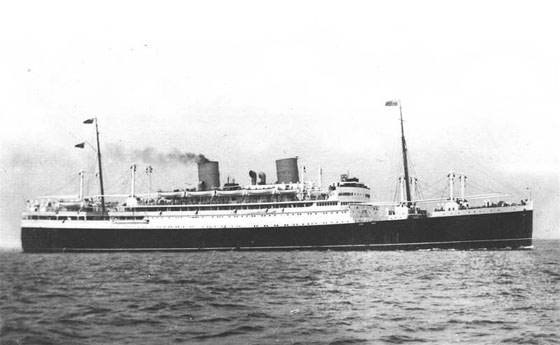
The Rangitiki, Rangitata & Rangitane were conceived of in 1925 and ordered in 1927 for the New Zealand Shipping Company for use on their United Kingdom - New Zealand service, as competition for other shipping lines. The order was placed with the John Brown Co, Glasgow, all three ships entered service during 1929. The regular service route was London - Curacao - Panama - Papeete - Wellington & Auckland. As an added attraction for the passengers the ships were routed to include Tahiti and Pitcairn Island, at the latter a two hour stopover allowed the local islanders to come out to the ship to trade their hand made curios with the passengers.
These were the first diesel powered ships ordered for the New Zealand Shipping Company. The existance of a contract between the British postal authorities and the shipping company allowed the use of the title 'Royal Mail Ship' for these three vessels.
The ships could be expected to make two and a half round trips each year. It would take thirty five days to travel from London to Auckland followed by twenty eight days to unload & reload the ship. Then it was another thirty five days back to London followed by forty two days to unload & reload prior to heading back to New Zealand.
Initially the ships operated from Plymouth but by the mid-1930's were operating out of the docks in London's East End. During the World War II their sailings were transferred to Liverpool.
October 1936 - The New Zealand Shipping Co., Ltd., announced that commencing with the sailing of 'Rangitiki' from New Zealand, November 19th 1936 they were doing away with Third Class in their motor vessels 'Rangitiki,' 'Rangitata,' and 'Rangitane', and substituting a new class called Tourist 'B' at reduced fares. The rates varied from £38 to £44 single and £69 to £80 return, according to the accommodation selected, and included passage from Australia to New Zealand. All fares were subject to exchange, but even with this addition the rates were extremely low for the accommodation & service provided.
![]()
Rangitiki
The Rangitiki was launched on August 29th 1928, her trials revealed an unstable condition when in ballast. Topside modifications were made to alleviate this condition prior to entering regular service. On February 14th a luncheon held on the ship included Sir James Parr, the New Zealand High Commissioner. The Rangitiki departed Southampton on her maiden voyage February 15th, 1929 to Wellington, New Zealand, sailing via Madeira and the Panama Canal. Journey time was about five weeks. Among the passengers on the maiden voyage were 79 migrants. After completing the return trip to the United Kingdom the ship underwent further modifications to improve her stability. These alterations affected the bridge structure including the associated deck, shortening of the two funnels, and the adding of more permanent ballast. These changes were made to the other two vessels prior to their delivery from the shipyard.
1929
1929 March 27th: Showing a brilliant mass of electric light, the new 17,500 ton motor ship, Rangitiki, built in Scotland for the New Zealand Shipping Company, arrived at Wellington at 10.30 p.m. on Wednesday, March 27th (says the New Zealand "Herald") from London and Southampton, via the Panama Canal. Owing to the late hour of the vessel's arrival at Wellington, it was impossible to berth her until Thursday morning, where a large crowd of interested spectators had gathered to witness the arrival of New Zealand's largest and most up-to-date passenger vessel in the Home trade. On boarding the liner one is immediately impressed with the vast amount of deck space available for games and dancing. A feature in this respect is the entire absence of hatch combings aft of the captain's bridge. Dummy hatches have been fitted on a level with the deck, so that several games of deck tennis can be played at the same time. The interior of the ship is decorated on a lavish scale, and some of the bedroom suites, which are panelled with polished and carved oak, have cost well over £1,000 to fit up. Polished mahogany is in evidence in many of the public rooms, which are all tastefully decorated. An innovation to the New Zealand passenger trade is the adoption of hand propelled lifeboats, which are worked by levers instead of oars. Each boat is equipped with ten levers, five on either side, and is built to hold 80 persons. The obvious advantage of such a lifeboat is that no knowledge of rowing is necessary. Small hand brakes are used to lower the boats, and electric motors, fitted with numerous safety devices, are employed to lift them from the water. Good weather was experienced during the greater part of the Rangitiki's uneventful voyage from Southampton. Passengers in the first, second and third classes were very favourably impressed with the excellent accommodation of the new motor liner. There is accommodation for 100 passengers in the First class, 80 in the Second class, and over 400 in the Third class. Passengers on this sailing included four missionaries headed for Siota in the Solomon Islands.
May 10th: departed Wellington for London, at Panama May 31st, at Southampton June 14th.
October 2nd: departed London for Wellington.
December 8th: departed Wellington for London, included in the cargo were 65,000 boxes of butter. At Panama December 27th, at Southampton January 9th, arrived London January 10th.
1930
January 18th: (Reported in London) Samuel Weir, 19, of Blantyre (Scotland) was charged at Eastham, England, with having stowed away on the Rangitiki. The prosecution alleged that Weir carrying a suitcase and a ukulele, boarded at Wellington among the passengers and told the steward that his cabin was No. 392. For 30 days Weir was served in the cabin with food, and participated in dances and entertainments. Then the rightful occupant of the cabin, which had not been engaged for the first part of the journey, arrived aboard. Weir had defrauded the company of £40. When challenged Weir said, "That's all right, my people will pay." A further sum of £3 was spent at Weir's request on wireless messages, but it was discovered that his people were not in a position to pay. Weir, who was smartly dressed, made no effort to conceal his amusement during the prosecution's recital of the story. He was fined £50. Llewelyn Williams, 32, laborer, who also had stowed away on the Rangitiki, told the magistrate that
he came home to see his mother. Officials of the ship stated that Williams had worked well on the voyage, and he was discharged with a caution.
February 15th: departed London for Wellington, arrived Wellington March 19th. On board was the new Governor-General of New Zealand, Lord Bledisloe.
April 27th: departed Wellington for London. On board the ship was explorer Rear-Admiral Byrd, travelling to Panama to rejoin his expedition's ship, Balboa was reached on May 14th, at Southampton May 29th, arrived London May 30th.
June 3rd: Radio telegraphy played the leading part in conveying to the world speedy information regarding the arrival of Miss Amy Johnson at Darwin recently. The Shell Oil Company's tanker Phorus, which was half way between Atamboea and Darwin, sent a wireless message when Amy passed over. This was received by Amalgamated Wireless' operator at Darwin. The first intimation received in Sydney of the air woman's arrival in Australia came in the form of a wireless message from Darwin to Sydney: 'Amy sighted.' As the plane circled the landing ground further messages arrived: Down, down, down, landed, so that the news reached Sydney at the moment the wheels of the 'Jason's Quest' touched the ground. Press correspondents in Sydney transmitted the news by Beam wireless to London, the messages being received within three minutes of the landing. When the first news was wirelessed from Darwin and repeated from Sydney Radio Station, Amalgamated Wireless' receiving station at La Perouse happened to be carrying on a conversation with the New Zealand Steamship Company's vessel Rangitiki, which was 1,500 miles off the coast of England. The Rangitiki before leaving New Zealand had been fitted by Amalgamated Wireless with special long distance wireless gear made in Australia, and she was in daily communication with Sydney by wireless throughout her trip to England. The Rangitiki thus received the news of Amy's landing less than two minutes after she reached Darwin.
July 2nd: On the eve of her 'maiden voyage' (?) after the changes, Prince George visited the ship and enjoyed a luncheon afterwards. At Colon July 17th 1930.
September 4th: departed Wellington for London, at Panama October 7th, arrived London October 20th.
November 20th: departed London for New Zealand.
1931
February 1st: departed Auckland for Southampton, at Panama February 20th, arrived Southampton March 6th and London March 8th.
April 12th: at Southampton, arrived Wellington May 14th.
July 24th: at London.
September 30th: arrived Auckland from London. The arrival was late due to tempestuous weather and the ship remained in stream but the authorities decided, despite the late hour to clear the vessel. This consequently caused the passengers to remain on deck, in various states of night attire and blankets until the medical examinations were done, the process being completed after midnight.
October 31st: departed Wellington, arrived Southampton December 12th and London December 13th.
1932
January 31st: at Colon, February 2nd at Panama for New Zealand.
March 25th: departed Wellington for London. At Panama April 13th, arrived London April 27th.
June 16th: at Colon.
July 7th: arrived Auckland from London. Passengers included Mr. Charles Chauvel, an Australian travelling with his wife, both having spent two months on Pitcarn Island, where an historic film of the Bounty mutiny was made. Presumably the Rangitiki had picked up the couple off Pitcairn.
August 25th: at Panama, arrived London September 8th.
October 27th: arrived Auckland from London.
November 25th: timetabled to depart Auckland for London, at Panama on December 15th, at London December 30th.
1933
January 12th: departed London for Wellington, at Plymouth January 14th, at Kingston January 26th.
March 17th: departed Wellington, April 6th at Panama, arrived London April 20th.
June 2nd: departed London and Plymouth June 3rd, at Colon June 16th.
August 23rd: at Panama, at London September 6th.
October 5th: at Colon. On October 11th well known Wellington pastoralist and racehorse owner Mr. Vivian Riddiford died on the Rangitiki whilst returning from England.
December 6th: at Panama, arrived London December 21st.
1934
January 26th: at Kingston, January 28th at Colon, January 30th departed Panama for Wellington.
March 17th: departed Wellington, arrived London April 19th.
June 14th: at Cristobal, June 16th at Panama for Auckland, arrived Wellington July 4th.
August 3rd: departed Wellington, at Panama August 23rd and Balboa August 24th, arrived London September 5th.
September 22nd: departed London for Wellington, arrived Auckland October 24th.
November 9th: departed Auckland, November 16th at Napier, at Balboa December 5th, arrived London December 19th.
1935
March 16th: departed Wellington for London, passengers included Lord Bledisloe, Governor-General of New Zealand and his family. Also on board was Rear-Admiral Byrd and his wife who disembarked at Balboa on April 5th to join his expedition ships (the Jacob Ruppert & the Bear of Oakland) for their return to New York. At Panama April 6th 1935, arrived London April 18th.
June 15th: at Cristobal.
July 31st: departed Wellington for London, the weather was bitterly cold and the passengers included the All Blacks rugby team. At Panama August 21st, arrived London September 2nd.
September 20th: departed London, at Cristobal October 5th, arrived Auckland October 23rd.
November 20th: departed Napier for London, December 8th at Balboa, December 10th at Colon.
1936
February 12th: arrived Wellington from London.
November 19th: departed Wellington for London. The New Zealand Shipping Co., Ltd., announced that, commencing with this sailing they were abolishing Third Class in their motor vessels 'Rangitiki,' 'Rangitata,' and 'Rangitane', and substituting a new class called Tourist 'B' at reduced fares. The rates vary from £38 to £44 single and £69 to £80 return, according to the accommodation selected, and include passage from Australia to New Zealand. All fares are subject to exchange, but even with this addition the rates are extremely low for the accommodation, service, and table provided. Arrived London December 24th.
1937
January 22nd: at Kingston, January 24th: at Cristobal, January 26th at Panama, arrived Auckland February 12th.
March 16th: departed Wellington, at Balboa April 4th, arrived London April 19th.
May 29th: departed London for Wellington, included in the passengers were some returning from the Coronation ceremony, at Cristobal June 11th, arrived Wellington July 5th.
August 3rd: departed Wellington for London. Suffering from a brain tumor, Frank Murphy, aged 12 years, left for London to seek special surgical aid, which was unobtainable in New Zealand. The visit to England was made possible by Toc H. The Central Otago padre of Toc H learned of Murphy's plight in Dunback, an isolated farming settlement. Calling a farmers' meeting, he raised £300 in 20 minutes. He communicated with a London specialist, and arranged an operation. The boy travelled with his mother. After arrival in London the surgery went as well as could be expected. At Balboa on August 22nd, at Panama August 24th, arrived London September 4th.
October 1st: at Cristobal, October 5th: depart Beira ??? (Balboa?) for New Zealand.
December 22nd: arrived London from Wellington.
1938
January 8th: departed London for Wellington, at Kingston January 24th.
March 31st: at Balboa, April 1st at Colon.
April 14th: arrived London from Wellington, the ship had been delayed due to rough weather. The ship was carrying 60 cases of exhibits destined for the Glasgow Exhibition. Despite the late arrival of the ship, the LNER laid on a special train to urgently rush the exhibits to the opening of the New Zealand pavilion at the Glasgow Exhibition. The Dominion exhibits arrived at Glasgow eighteen hours after the arrival of the Rangitiki.
June 10th: at Cristobal, June 14th at Panama.
September 1st: arrived London.
October 20th: arrived Auckland from London. (Reported from Auckland), on the just completed trip from London a Mr Freeman aged 65, an English tourist died and was buried at sea, Commander Barnett officiated. The liner Rangitiki, which arrived here today from London, visited Pitcairn Island where it was confirmed that a rumour that typhoid fever had broken out was unfounded. The islanders had suffered some hardship as the vessels which usually called had been giving the island a wide berth.
December 8th: at Balboa, December 10th: arrived Colon, arrived London December 24th.
1939
January 7th: departed London, at Kingston January 31st, arrived Auckland February 12th.
March 9th: departed Wellington for London, March 29th at Balboa, April 1st at Colon.
May 22nd: departed London, arrived Wellington June 29th.
July 28th: departed Wellington for London, at Balboa August 16th, Panama August 17th.
World War Two
With the arrival of World War II the ships continued to make their long journeys across the globe, though their 'passengers' would now have special needs, such as the transport of many children from the United Kingdom to safer places such as Australia, and later for the movement of troops to many destinations. These movements were fraught with danger, particularly on the North Atlantic crossing with the threat of attack by U-Boats, surface raiders and aircraft. In November 1940 the Rangitiki sailed with thirty seven ships as part of Convoy HX84 from the USA to the UK, the ship's large profile with its two funnels would make it a prime target should the convoy be attacked. The German pocket battleship Admiral Scheer located and attacked the convoy in the middle of the Atlantic, which was ordered to scatter. The only Allied escort, the Armed Merchant Cruiser HMS Jervis Bay drew fire from the Admiral Scheer allowing the prime target of the Rangitiki to escape along with thirty one other members of the convoy.
1940 November 12th The New Zealand High Commissioner in London reported that the Rangitiki had escaped shelling by a German raider whilst in the Atlantic, about 1,000 miles east of Newfoundland. German reports said the convoy had sustained serious casualaties ('annihilated') on or about November 7th, the lack of further radio messages supported the German propoganda claims that the German surface raiders had been successful in sinking the ships. It is reported that all the women passenger on this voyage kissed the Captain prior to leaving the ship in England, in thanks for completing the voyage safely. While the action was going on the women were assembled in an alleyway wearing their lifebelts. Two hours later, after the action had finished dinner was served as if nothing had happened. The Captain came down to the saloon for a few minutes and advised the ladies he hadn't had a change of clothes in a week.
Another German capital ship to set its sights on a convoy that included the Rangitiki was the heavy cruiser Admiral Hipper. Whilst sailing as part of Convoy WS5 late in December 1940 the Admiral Hipper commenced shadowing the convoy southwards some seven hundred miles west of Cape Finnesterre. The Admiral Hipper chose to wait for the daylight of Christmas Day 1940 prior to attacking what it thought was a normal trade convoy. This assumption was quickly proved wrong to the Admiral Hipper when the first ship it attacked was the heavy cruiser Berwick. The Hipper diverted its fire to the scattering convoy and was able to seriously damage the Empire Trooper. The threat of a torpedo attack from the Allied destroyers led to the Hipper breaking off the action. The convoy reconstituted and reached Freetown on January 6th 1941, spending two days here prior to sailing for Cape Town, reaching here on January 21st 1941. After passage through the Red Sea the convoy reached Suez on February 16th 1941.
On August 3rd 1941 the Rangitiki sailed with convoy WS 10 from the United Kingdom bound for Suez. Freetown was reached on August 17th 1941, leaving on August 21st 1941, Rangitiki was in the section of ships bound for Durban for refuelling. Suez was reached late in September 1941. Also sailing as part of this convoy was the Sulzer powered Indrapoera. By late October Rangitiki was noted at Columbo, sailing from here on October 31st 1941 as part of convoy WS 11X for Singapore, arriving here on November 6th 1941.
The Rangitiki sailed from the Clyde on June 29th 1942 as part of convoy WS 21. Also in the convoy was the Sulzer powered Aorangi. Freetown was reached on August 10th 1942, departing August 15th 1942. Cape Town was passed on August 27th 1942, the Rangitiki being in the group of ships set to refuel at Durban, though the ultimate destination for the Rangitiki is not recorded.
On December 12th 1942 the Rangitiki sailed from the United Kindom as part of convoy WS 25. The convoy arrived at Freetown on New Year's Eve 1942 and departed on January 3rd 1943. Durban was reached on January 18th 1943 where the ships dispersed to various destinations.
The Rangitiki sailed from the United Kingdom on June 21st 1943 as part of the joint convoys WS 31 & KMF 17. The latter convoy was bound for the Mediterranean, the split occurring on June 26th 1943, the Rangitiki going east with convoy KMF 17.
The Rangitiki was equipped with a stern mounted gun and possibly anti-aircraft guns.
Troop movements included visits to ports on the North African coast, the ship was present at Mers-el-Kebir, Algeria having brought in troops from the United Kingdom for the invasion of North Africa.
1945 - Postwar
1945 September 8th: the slightly delayed arrival in Sydney (No.8 Wharf, Glebe Island) of the Rangitiki from Liverpool. The journey had taken exactly six weeks with stops only in Colon and Wellington. On arrival at White Bay (Sydney) a nearby American Liberty ship sounded off a welcome with its siren, quickly followed by every other boat in the vicinity letting go with its whistle, siren or horn. The Rangitiki disembarked 213 former Australian prisoners of war, 27 members of the RAAF and 11 men in New Zealand uniforms, some had been held prisoner of war for at least four years. In celebration of their return four double decker buses were laid on to present them to the city, the people lining the route greeted them with a rapturous welcome.
1946
January 3rd: Four hundred wives and children of Australian and New Zealand servicemen sailed on the ship from London to join their husbands. On January 11th at Valetta sixty four Maltese men, women and children boarded the Rangitiki at Valetta to join relatives in Australia. It was the first party of Maltese immigrants for Australia since the war began. Included in the passengers were two Scottish sisters, aged 74 & 76 who had lived in Malta for 55 years and were to live with one of their daughters. The ship sailed via Suez and arrived at Melbourne on February 8th, from here twenty six British wives of Australian servicemen disembarked and headed for Brisbane.
March 4th: arrived Sydney, prior to sailing for London nearly 18,000 bags of food parcel mail were loaded onto the Rangitiki, which left Sydney March 8th. This is thought by shipping companies to be a record consignment for any one passenger ship. The Rangitiki also carried almost 800 passengers, which is understood to be the largest complement of civilians to leave Australia since before the war. The vessel would also embark a further 80 passengers at Fremantle on March 15th, also in port at the same time were seventeen Allied warships. Many Australian warbrides were on the ship headed to England. By April 7th Port Suez had been reached, by April 14th the Rangitiki had docked at Southampton without the aid of tugs, 120 tugmen were on strike, their 14 tugs were not available for duty. According to one of the passengers the ship had broken down with engine trouble several times on the trip.
June 1st: passed Gravesend for Wellington, at Balbao June 28th.
July ??: Rangitiki reported stopped at Panama for 13 days with engine problems.
September 5th: at Balboa.
1947
February 4th: Sydney, arrived in Sydney from Auckland - the Royal suite on the liner Rangitiki, on which the Duchess of Gloucester and the young Princes William & Richard would travel to London, had been restored to its prewar furnishings (similar in furnishing to pre-war first class accomodation), though some of the materials were of wartime manufacture. The stateroom was panelled in walnut, a lounge and easy chairs were covered with pale blue material. The Princes' stateroom on the port side had been repainted and contained two beds and a small table, with four small chairs. Stewards advised that the Duchcess expressed a wish to join the other passengers to dine in the saloon, C P Overall the ship's chef said the menu for all on board would be plain, no special food had been requested for the Royal party. The Duchess had been in Australia for two years. The Duke of Gloucester had flown home commencing January 16th in his Avro York, Endeavour, in order to reach London before the King travelled to South Africa. Passengers who arrived in the ship from New Zealand said that accommodation elsewhere in the ship was 'pretty bad'. The ship had arrived early from Auckland on February 3rd and would depart Sydney on February 6th. En route the ship stopped on February 22nd off Pitcairn Island to recieve eighty islanders. They had rowed out one and a half miles to the ship, then clambered up rope ladders to meet with the Duchess and the Princes. It is reported as being the first Royal visit to Pitcairn. Most of the visitors did not wear shoes. The ship would reach London on March 21st, two storms were encountered during the crossing, a major one in the Pacific with strong headwinds and a lesser one in the Atlantic. Additionally whilst crossing the Pacific one of the engines broke down.
March 13th: (Auckland) - Twelve stewards deserted the liner Largs Bay before she sailed for England via Sydney. Other members of the crew deserted previously but replacements were secured from young men eager to get to England. There had been a flood of desertions from visiting ships. Eighteen stewards deserted from the Rangitiki earlier this year. All the deserters cheerfully face a month in gaol as the penalty for settling here.
June 16th: arrived Auckland from London.
August 12th: Departure had been delayed due a waterfront dunnage dispute. The largest number of people ever to leave New Zealand in a liner in peace-time would depart from Auckland by the Rangitiki on August 12th. Totalling 770, they would include 360 passengers for America. Noted at Cristobal on September 7th and Curacao September 11th. The ship sailed from Halifax on September 17th, en route from Wellington to London, arriving at Tilbury on September 23rd. Amongst the passengers were approximately 200 returning British people who had emigrated to New Zealand during the last 18 months and who, for whatever reason, had not wished to settle down in New Zealand.
November 8th (New York): Captain Edward Holland, master of the passenger liner Rangitiki, of the New Zealand Steamship Company, during a stop here (New York) en route to England, said his ship would be reconverted as a luxury liner following its current voyage. The vessel was fitted as a troopship, but after reconversion by builders at Clydebank, Glasgow, at a cost of about £300,000, it would return to luxury service. On its New Zealand - New York - Britain voyage, 771 passengers were carried, discharging 349 of them in New York. Captain Holland said new engines were to be installed to give the ship an increased speed and enable it to reduce the time of its regular England - New Zealand run, via the Panama canal, from 32 to 28 days.
1948
After a decade and a half of long distance service, including the challenges of five years of wartime operations the time had arrived for refurbishment of the two remaining ships prior to their long term return to their bread & butter workings. Thus for ten months during 1947/48 each ship was refurbished at a cost of £1,500.000. This included the removal of the Sulzer engines with replacement Doxford vertically opposed two-stroke diesels, providing an increased output of 12,920bhp.
Following the refurbishment of the Rangitiki & Rangitata the New Zealand Shipping Company produced a brochure of the passenger improvements made to the two ships.
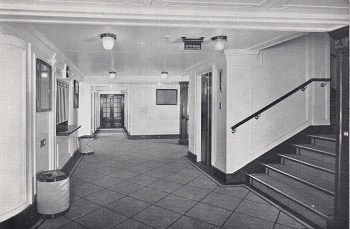
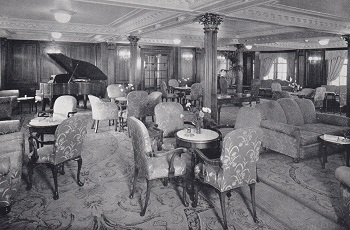
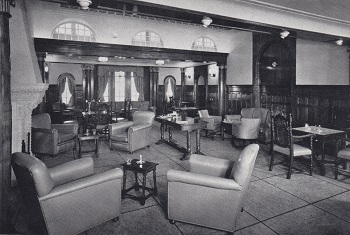
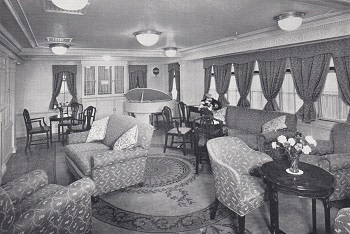
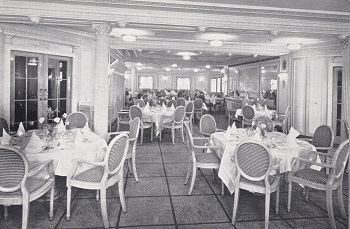
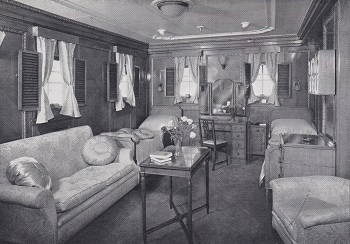
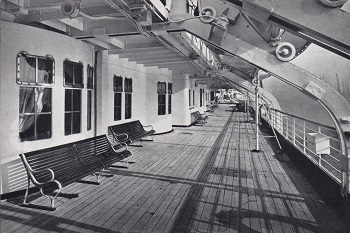
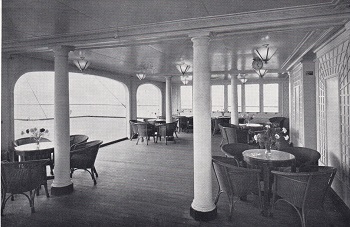
The first voyage of the refurbished Rangitiki commenced on September 26th 1948. The trip from Southampton to Wellington took five weeks, noted Curacao on October 8th, Cristobal October 10th, arriving on October 27th 1948. Passengers and crew on this trip encountered very mixed weather conditions - a week of hurricane force conditions was followed by a heatwave towards the end of the voyage.
1949
January 13th: arrived London.
December 3rd: (London) - Lord Nuffield sailed for Australia and New Zealand in the Rangitiki, the trip would include visits to Morris car distributors. In an interview, he condemned the Government's curtailment of the number of cars allowed for the home market. "No industry can build a healthy, increasing export trade on a crumbling domestic market." he said.
1950
March 19th: London - thirty passengers were injured — one so seriously that she was rushed ashore on a stretcher on arrival at Southampton when the Rangitiki battled through a 60-mile an hour gale on a voyage from New Zealand. The stretcher case was Miss Mabel Saunders. a 44-year-old New Zealand teacher. She was knocked down the companion way by a piano that hurtled across the lounge. She was taken to hospital with a suspected fractured pelvis. Twenty nine other passengers were treated for cuts and bruises. Miss Erica Slim, a New Zealand passenger, told reporters, 'A woman of 82 slipped from a chair at lunch and slid from one end of the dining room to the other. Crockery was shattered and chairs and tables overturned.' The ship's officers said the gale was the worst they had seen for 20 years.
April 24th: passing Gravesend for Wellington.
1951
January 2nd: arrived Southampton from New Zealand.
March 4th: Wellington - on his 13th visit to New Zealand, Viscount Nuffield arrived at Wellington in the Rangitiki. He would spend a week in New Zealand before going to Australia to inspect his firm's new factory. A waterfront strike caused delays in the unloading of the ship, with the 426 disembarking passengers assisting in getting their luggage ashore. They were assisted by air forcemen working the docks.
1951 May 5th: departed Auckland for London with 418 passengers. The cargo in the Rangitiki had been loaded by servicemen, filling in for striking watersiders - they had also handled the loading of cargo for two other ships sailing for London, the Port Auckland and the Tamaroa. Midway between the Azores and Lands End an emergency two hour surgery was carried out on Mrs Elsie Le Roy, aged 39 of Napier NZ, who had become severely ill from internal bleeding. By chance one of New Zealand's leading surgeons, Sir Bernard Dawson, was travelling on the ship, and with help from the ship's medical staff and passengers with medical knowledge, the surgery was carried out. It had been determined that the patient could not wait until reaching England to have the surgery. The ship's fourth engineer, Alec Milne, improvised the making of three sets of surgical retractors. The Rangitiki was at London on June 8th but the unloading of her cargo which included 1,700 tons of meat, 2,500 tons of butter and 950 tons of cheese was held up by 1,400 striking tally clerks who were upset about the engagement of non-union members. 8,000 dockers were unable to work because the tally clerks were not checking the cargoes. 80 ships were idle whilst 11 were undermanned.
1952
November 30th: expected at Southampton from New Zealand. (Reported London November 26th) Alfred William Evans, 56, who was travelling with his wife and two children in tourist class, was found hanged in a locked cabin on the Rangitiki on Monday (24th) and buried at sea.
December 26th: departed Auckland for London, rooms were available for 150 first and tourist class passengers, an indication of the declining passenger trade for these ships.
1954
December 4th: when Channel Pilot Wilfred Glassborrow boarded the Rangitiki at Tilbury to pilot the ship to Dungeness he was not expecting a 6,000 mile voyage to the Dutch West Indies. Bad weather did not allow the pilot to be dropped off as scheduled, resulting in an unscheduled trip to the Caribbean.
1955
December 22nd: arrived Southampton from Auckland.
1960s
During 1961 on the fourth to last voyage whilst crossing the Pacific heading towards Panama the bottom skirt of a piston became disconnected and dropped out of the piston liner. The engine stopped quickly but caused serious damage. The one good engine took the ship to Callao, Peru where engineers dismantled the unit and sealed off the scavenges with welded steel plates, allowing the ship to make it home to London with the damaged engine operating with five pistons.
As with many other ocean passenger services, times had changed for Rangitiki with air travel and newer ships creating declining passenger loadings for this veteran. A replacement vessel was obtained, being the retired Cunard passenger-cargo liner Parthia, which was renamed Remuera. On the last voyage out to New Zealand the Rangitiki passed the Rangitata on her final voyage to the UK. The ships passed close enough for passengers and crew to raise a cheer and recognise that this event would not happen again for these two ships. The final voyage (number 87) from Wellington occured in May 1962 arriving at Southampton on July 11th 1962 with 324 passengers and one stowaway, London was reached on July 13th 1962.
The ship was sold for scrap, with a skeleton crew it made the brief voyage to Santander, Spain arriving on July 26th 1962. She was later broken up for scrap in Valencia.
TROVE NEXT PAGE 44 (last 840)
![]()
Rangitata
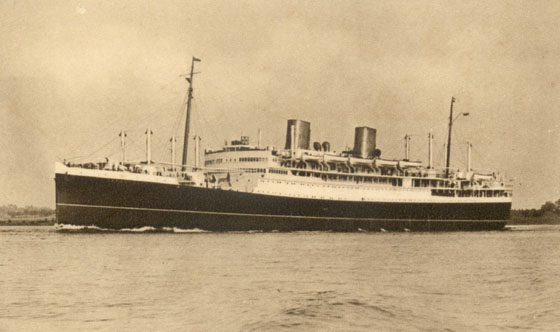
Rangitata was completed in October 1929 and commenced her maiden voyage to New Zealand on November 22nd 1929.
In July, 1930 a little over one year into her long career, Rangitata was in the news having rescued the crew of the cargo ship Targis, which had caught fire in the South Atlantic.
As well as her passenger complement the Rangitata carried a wide variety of cargo. On a sailing from London to Wellington in March 1935 the ship carried four crated Vickers Vildebeest aircraft for the New Zealand Air Force. The planes arrived safely in Auckland on April 1935. Most of this shipment of aircraft had relatively short flying careers, most had been written off in accidents by 1940. However the second of the batch shipped, number NZ102 Mk III Type 277 survived at least until 1944 and eventually was put on display at RNZAF Museum, Wigram.
In 1937 the Rangitata carried Anzac troops to England in celebration of the coronation of King George VI.
During December 1939 the Rangitata was requisitioned as a personnel carrier and served as a passenger transport ship until 1941 when it was converted to a troopship with a capacity of 2,600 troops.
On January 6th 1940 the Rangitata with 450 New Zealand troops departed Wellington NZ with a number of other ships bound for the Middle East. The ships first travelled to Sydney, all remaining at sea except for one vessel which briefly entered Sydney harbour. Whilst at sea again the Rangitata maintained the next to last position on the starboard side. There were twelve passenger vessels protected by a battleship, eight cruisers, an aircraft carrier and a destroyer. It was a calm sailing to Fremantle where shore leave was granted to visit Perth. Several days after resuming the voyage a man fell overboard from the liner Orcades which occupied the position in front of the Rangitata. Observant crew members queried the dark mass in the water, presumed it was person and threw down a life buoy, the Captain ordered the ship to turn about, slow down and launch a lifeboat at the the appropriate moment to successfully rescue the man. Later that day a message came from the battleship that they would be stopping briefly for a ceremony to mark the death & burial of a young sailor on the ship. Following the ceremony as the battleship regained its position all the other ships lowered their flags to half-mast. On arrival at Aden the faster ships sped off to Suez to avoid congestion in the canal zone, for those on the Rangitata there was brief shore leave at Aden. On arrival at Suez the troops from the Rangitata took the train to Maadi for further dispersal to the war front (i).
With the bombing of many cities in the United Kingdom a plan was set in motion to transport children to safer areas within the colonies. One such sailing took place from Liverpool during September 1940 to New Zealand arriving there during the first week of October 1940.
On February 9th 1941 the Rangitata set sail from the United Kingdom as part of convoy WS6A bound for Suez. The convoy reached Freetown on March 1st 1941, it is not recorded as to whether the Rangitata then sailed for the next stop of Cape Town or Durban. The convoy reached Suez late in April 1941.
On June 30th 1941 the Rangitata formed part of convoy WS 9B bound for Suez. The convoy arrived at Freetown on July 13th 1941 and sailed out on July 16th 1941, with the Rangitata bound for Cape Town. The Rangitata detached from the convoy here, its destination is not known.
On April 15th 1942 the Rangitata sailed from the United Kingdom as part of convoy WS 18. Freetown was reached on April 29th 1942, departing here on May 3rd 1942. The convoy arrived off Capetown on May 15th 1942, the Rangitata was in that part of the convoy due to refuel at Durban. However a minefield had been laid recently by the raider Doggerbank, two ships fell victim to the mines. After unloading at Durban it appears the Rangitata returned to the United Kingdom.
The Rangitata sailed from the United Kingdom on August 29th 1942 as part of convoy WS 22, also sailing in the convoy was the Sulzer powered Johan Van Oldenbarnevelt. Freetown was reached on September 9th 1942, departure was on September 13th 1942, joining the convoy at Freetown was the Sibajak, another Sulzer engined ship. The convoy reached Cape Town on September 25th 1942, however for the Rangitata the refuelling would take place at Durban, arriving here on September 29th 1942. Here the convoy was joined by several other ships including the Sulzer engined Felix Roussel & Indrapoera! These five ships would not remain together long, the Rangitata arrived at Mombasa on October 12th 1942, the others split between Aden/Suez & Bombay.
Joint convoy WS 28 & KMF 11 sailed from the United Kingdom on March 16th 1943 including the Rangitata & the Johan Van Oldenbarnevelt. On March 21st 1943 the convoys split with KMF 11 heading into the Mediterranean which included the two Sulzer engined ships.
Convoys KMF 20 & WS 32 sailed from the United Kingdom on July 27th 1943, included in the WS 32 section was the Rangitata. On the evening of July 25th 1943 the KMF 20 section headed east, whilst WS 32 headed south, reaching Freetown on July 28th 1943. At Freetown the convoy increased by two ships and sailed on August 5th 1943, reaching Cape Town on August 18th 1943 and Durban on August 22nd 1943. Five ships sailed on from here to Aden/Suez & Bombay but the Rangitata was not one of them.
The Rangitata was returned to civilian control August 15th 1946. Like the Rangitiki it returned to its familiar London - Panama - Wellington route, including the transport of many people leaving the United Kingdom for a hoped for better life in New Zealand.
During the middle of September 1946 the Rangitata departed London's Tilbury Docks destined for New Zealand with a passenger manifest that included many people en-route to New Zealand to establish a new life for themselves. One such family, on an assisted passage were headed to New Zealand, the father had seen service in the Royal Navy in the Pacific theatre and visited New Zealand on leave. The impressions from this visit were sufficient to consider emigration from the United Kingdom to New Zealand after the war's end. After discharge from the service, the father headed for Wellington, arranging passage for his family to join him. On the journey the mothers were housed in four-berth cabins whilst the children slept separately in a dormitory several decks away from their parents! Memories include passing the white cliffs of Dover, open air movies whilst crossing the Indian Ocean and witnessing the 'Crossing the Line' (Equator) ceremony. A short lived tropical hail storm was encountered, leaving much ice briefly on the deck. The travel did not always sit well with some, a young man, maybe twenty years old exhibited bizarre behaviour before donning a life jacket and jumping overboard. Quick action saw the ship positioned to rescue the young man from the endless ocean. For the remainder of the voyage he was kept separate from the others and when on deck was under the careful watch of crewmembers. Wellington would be reached on Labour Day, October 28th 1946, but the wharf workers were not working that day, so the ship berthed on Tuesday morning. The family were quickly reunited and headed north from Wellington to begin a new life in the agricultural community (ii).
During 1957 Sir Anthony Eden, the former Conservative Prime Minister, took a cruise on the Rangitata.
On a northbound crossing December 1959/ January 1960 the Rangitata ran into a storm in the Atlantic some 1,600 miles out from England. During the storm the timing chain on the starboard engine broke, putting the engine out of action. It took quite a while to fix the timing chain, the remaining engine providing steerage to combat the stormy weather.
After her final voyage to the United Kingdom in May 1962 the Rangitata was sold to Dutch breakers who renamed her Rang. However the reprieve was brief, she was duly sold to a Yugoslavian Company who had her broken up by a breaker in Split.
Sources:
(i) The Troopship by CAL Treadwell, one of a number of stories in Lady Newall's New Zealand Gift Book, published by the The New Zealand Society of Authors (P.E.N. NZ Inc), Wellington, NZ, in 1943.
(ii) Memories from Michael Steemson travelling as a 10 year old with his family to New Zealand.
![]()
Rangitane
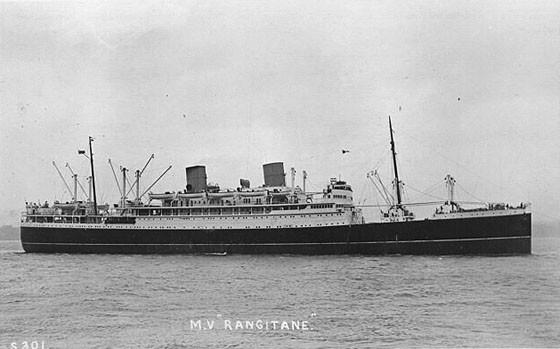
Rangitane was the last of the trio to be built by John Brown of Clydebank. She was completed in November 1929, and departed Southampton on December 20, 1929 for her maiden voyage to New Zealand. And like her two sisters the Rangitane would spend the next ten years plying between the United Kingdom and New Zealand.
Rangitane = Chieftan
1929 - 1930
December 20th 1929 departed London for New Zealand (maiden voyage) with Captain AW McKellar and a crew of 194, Southampton (21st), Madeira (25th), Colon (January 4th), refuelled Balboa (January 4th, departed 5th), arrived Wellington January 25th 1930
March 2nd 1930 departed Wellington for London, April 4th Southampton & April 7th arrived London
May 8th departed London for NZ, June 13th arrived Auckland
July 20th departed Wellington for London, Aug 8th Colon, Aug 20th Southampton
September 26th departed London for NZ, Oct 11th Panama, Oct 29th arrived Auckland
Nov 15th departed Wellington for London, Dec 6th Auckland, Dec 30th Colon, Jan 11th 1931 arrived London
The Rangitane arrived at Southampton on Wednesday August 22nd 1930, having completed her voyage from Wellington in 31 days and 9 hours at sea, which was believed to be a record. The average time for fast ships for this trip would be 33 to 34 days.
Four days after departure from Southampton (about September 30th) third class passenger Mrs S A Morison fell from the Rangitane and died from injuries sustained after hitting the water. A ship's boat recovered the body.
1931
February 12th departed London for NZ, Feb 27th at Colon, March 19th arrived Wellington
April 25th* departed Wellington? for London, May 29th Southampton for London
July 4th departed Southampton for NZ, July 10th Panama, Aug 6th 1931 arrived Auckland, Aug 15th Wellington
Sept 2nd departed Wellington for London, Sept 12th Auckland, Oct 3rd Colon, Oct 15th Southampton, Oct 16th London
Nov 18th departed London for NZ, Nov 19th Southampton, Dec 4th Panama, Dec 22nd arrived Wellington
The arrival of the Rangitane at Wellington included a huge amount of Christmas mail from the United Kingdom.
One of the passengers who boarded at Southampton on November 19th for the journey to Wellington would unfortunately not complete the journey. Isobel Brownlee Reynolds died en-route on November 27th 1931 and is presumed to have been buried at sea shortly thereafter. Mrs Reynolds who was challenged by poor health had travelled from New Zealand to England during May 1930, accompanied by her nurse Jane N Johnston. Whilst in England Isobel and her nurse sailed to Genoa in early September 1931 on the Johan Van Oldenbarnevelt (another Sulzer powered ship). How & when they returned to England is not known, but it was in time to depart Southampton on November 19th 1931 on the Rangitane. (Information about Isobel graciously provided by Victoria Gittings).
1932
Jan 30th departed Wellington for London, Feb 19th Panama, Feb 20th Colon, Mar 5th Southampton, Mar 6th arrived London
April 23rd Colon, May 13th arrived Auckland, May 19th arrived Wellington
June 14th* departed Wellington for London, July 5th Colon, July 18th arrived London
November 5th Colon, Nov 24th arrived Wellington (delayed due to bad weather)
December 23rd departed Wellington for London.
December 1932 - Macdonald, Hamilton, and Co., the Brisbane agents of the New Zealand Shipping Co., Ltd., with reference to their service via Panama Canal, advise that in the Rangitiki, Rangitata, and Rangitane the second saloon accommodation will in future be rated as tourist saloon, and the minimum single fare will be £45 in four berth cabins. The new rating will come into force with the Rangitane leaving Wellington on December 23rd.
1933
January 12th Panama, Jan 26th arrived London
March 14th arrived Wellington
April 13th departed Wellington for London, May 5th Panama, May 17th arrived London
June 29th departed London for NZ, July 1st Plymouth, July 14th Colon, August 3rd arrived Auckland
Sept 1st* departed Wellington for London, Sept 20th Panama, Oct 4th arrived London
October 19th departed London for NZ, Oct 21st Plymouth, Nov 2nd Panama, Nov 22nd arrived Wellington
December 16th departed Wellington for London
1934
January 10th Panama, Jan 12th Colon, Jan 25th arrived London
Feb 8th departed London for NZ, Feb 10th Plymouth, Feb 24th Colon, Mar 16th arrived Auckland
April 15th departed Wellington for London, May 5th Colon, May 18th arrived London
June 23rd departed London for NZ, June 30th Plymouth, July 12th Cristobal, July 16th Panama, July 31st Auckland
August 31st* departed Auckland?? for London, September 19th Balboa, Oct 4th arrived London
October 18th departed London for NZ, Nov 3rd Cristobal, Nov 22nd Wellington
December 21st 1934 departed Wellington for London
1935
January 8th Balboa, Jan 23rd arrived London
February 8th departed London for NZ, Feb 21st Kingston, Feb 23rd Cristobal, Mar 13th arrived Wellington
Mar 28th departed Wellington for London, Apr 13th Auckland, May 2nd Balboa, May 16th Plymouth, May 18th arrived London
June 29th departed London for NZ, June 30th Plymouth, July 31st arrived Auckland, Wellington Aug 5th - damaged generator
Sept 10th departed Wellington for London, Sept 27th Auckland, Oct 16th at Balboa, Oct 30th arrived London
Nov 15th departed London for NZ, Nov 30th Colon, Dec 17th arrived Wellington
August 1935 Auckland - An unexpected voyage round the world has fallen to the lot of 12 valuable young homing pigeons which arrived at Auckland by the Rangitane. Sixteen pigeons were taking part in races from England to France, in which the King was competing, but they were evidently blown out of their course, and they fell exhausted on to the Rangitane on June 10th (or 30th?) when the vessel was 700 miles (?) from land. When an effort was made to care for them four of them tried to fly away but they fell into the sea and were drowned. The remaining 12 responded to treatment and recovered. They were returned to England, it is not known whether any of the birds belong to the King.
On arrival at Weliington about August 5th, the Rangitane was taken out of service in order to make repairs to an armature on one of the two 550kW generators. Replacement parts were taken from the Rangitata and expected to arrive in Wellington about August 12th. Parts to replace those removed from the Rangitata were to be ordered from England, with the Rangitata's July 25th departure from London taken up by the Tongariro.
On December 17th the Rangitane arrived at Wellington with 1,816 bags of Christmas mail from the United Kingdom, the ship had berthed at 6.45pm, unloading of the mail bags began at 8pm and they had been completely removed by 2.15am of 18th.
1936
January 16th departed Wellington for London, Feb 4th Balboa, Feb 5th Colon, Feb 6th Kingston
March 5th departed London for NZ, Mar 21st Cristobal, April 7th arrived Auckland
May 8th departed Auckland for London, May 27th Balboa, May 30th Colon, June 10th arrived London
July 23rd departed London for NZ, July 25th Plymouth, Aug 30th arrived Wellington
Sept 25th departed Auckland for London, Oct 14th Balboa, Oct 17th Colon, Oct 27th arrived London
Nov 13th departed London for NZ, Nov 28th Cristobal, Dec 1st Panama, Dec 16th arrived Wellington
The Rangitane sailed on July 23rd 1936 from London for New Zealand, but en-route the shroud of the main driving wheel broke during the first week of August. By August 10th the ship was stopped at Christobal for repairs. A spare part was being shipped from Southampton by the United States liner Manhattan which is expected to reach New York on August 6th, from where it would travel by aeroplane to Panama.
September 2nd 1936 Wellington - Frederick James, 26, and Peter John Frederick Ransom, 17, stewards on the Rangitane, who were charged on arrival here from London on Monday with the theft between Panama and Wellington of money and drafts valued at £710, belonging to the New Zealand Shipping Company, pleaded guilty to-day and were committed to the Supreme Court for sentence. The chief steward on the Rangitane, Maughin, said in evidence that on returning to his cabin at 10.45 p.m. on August 15, when the ship was between Panama and Wellington, he examined the safe in the office adjoining and found that all the ship's cash, £410, and letters of credit and a bank draft, of a total of £300, were missing. The accused were interviewed, and they confessed, although Ransom at first denied the theft. Ransom was attached to the office. All the money had been recovered, but the accused said that the letters of credit had been thrown overboard. James had been on the boat for five and a half years, and Ransom for two years.
Mr. W. C. Gough, a Scotland Yard, London official, was aboard the Rangitane, coming to New Zealand on holiday, when it was discovered that the purser's safe had been robbed. His services were requisitioned and resulted in the rapid recovery of the money. The robbery occurred while the passengers were at dinner, the thieves escaping unseen. When the robbery became known and no immediate arrest or recovery of the property was made, some of the passengers impatiently scoffed, saying, 'What? We have a celebrated detective aboard, yet this sort of thing goes on Surely he can do something about it?' Mr. Gough. however, was quietly investigating, and as a result the property was recovered almost intact.
1937
Jan 14th departed Wellington for London, Feb 2nd Balboa, Feb 4th Colon, Feb 17th arrived London
Mar 6th departed Plymouth for NZ, Mar 20th Cristobal, Mar 23rd Panama
May 6th departed Wellington for London, May 25th Balboa, June 8th arrived London
July 23rd departed London for NZ, July 24th Plymouth, Aug 6th Cristobal, Aug 10th Panama, Aug 25th arrived Wellington
Sept 23rd departed Auckland for London, Oct 13th Balboa, Oct 14th Colon
Nov 12th departed London for NZ, Nov 13th Plymouth, Nov 27th Cristobal, Nov 30th Panama, Dec 16th arrived Wellington
February 1937 (London) - Two young men aged 19 & 16 were charged with having stowed away in the Rangitane in New Zealand. It was alleged that they became troublesome on board, and although handcuffed, walked ashore in Jamaica. When found, they had filed their handcuffs through with a knife. John Green was sentenced to a month's imprisonment whilst his companion was sent to a remand home.
Shortly after leaving London for New Zealand the Rangitane fractured the No.5 piston and liner on the starboard engine and put into Plymouth on November 13th 1937 for repairs, departing Plymouth the next day.
1938
Jan 13th depart Auckland for London, Feb 6th Balboa, Feb 8th Kingston, Feb 22nd arrived London
Mar 6th departed Plymouth for NZ, Mar 22nd Panama, April 9th arrived Wellington
May 5th* departed Wellington? for London, May 31st Balbao, June 1st Colon, June 14th arrived London
July 22nd departed London for NZ, July 24th Plymouth, Aug 6th Cristobal, Aug 10th Panama
Sept 22nd* departed Wellington for London, October 15th Colon, Oct 28th arrived London
Nov 11th departed London for NZ, Nov 13th Plymouth, Nov 27th Cristobal, Nov 28th Panama, Dec 16th arrived Wellington
Following the completion of the voyage from Auckland to London, arriving February 22nd, Captain A W McKellar ended a career of fifty years at sea, which included being the captain of the Rangitane from 1930 - 1938. Captain H L Upton took over the captain's position on the Rangitane.
On the westbound voyage arriving at Wellington on December 16th it is reported a ship's steward was lost overboard en-route, despite a search the body could not be found.
1939
Jan 17th departed Wellington for London - departure delayed due to bad weather, Feb 7th Panama, Feb 8th Kingston, Feb 21st arrived London
Mar 4th departed London for NZ, Mar 5th Plymouth, Mar 19th Cristobal, Mar 21st Panama, April 7th arrived Wellington.
May 4th* departed Auckland?? for London, May 25th Cristobal, May 27th Colon, June 9th arrived London
July 21st departed London for NZ, Aug 4th Cristobal, Aug 11th Panama, Aug 24th arrived Auckland
Sept 23rd* departed Auckland for London
The arrival of the Rangitane at Wellington on April 7th included twelve European refugees who had boarded the ship in London after escaping from Austria following Austria's takeover the Germany.
1940
Jan 11th* departed Auckland? for London
Unlike her two sisters, which would see the war out, the Rangitane would become a casualty of hostilities during World War II.
The Rangitane's last southbound sailing started on September 25th 1940 from Liverpool bound for Wellington. Included in the passenger list were 113 children en-route to a safer life in New Zealand. Unfortunately a week before the City of Benares had been torpedoed and sunk with the loss of 77 children being evacuated from the UK. In the week following further children continued to sail out of the UK, but the Rangitane would reverse course and her young passengers disembarked back at Liverpool, with a quick turn round and her speed, the Rangitane was able to catch up with the convoy.
It would be late November before the Rangitane was ready to sail northwards, loading 14,000 tons of cargo was a time consuming task. And whilst making this voyage the Rangitane crossed paths with two German merchant raiders, the Komet and the Orion, some 320 miles north of East Cape, New Zealand. The story starts however with another vessel, the SS Holmwood, a 546 ton steamer which was travelling from the Chatham Islands bound for Lyttleton with several passengers and a cargo of sheep. Its journey would put it in close proximity to the Rangitane.
The three German raiders, the Komet, Orion and Kulmerland had been on patrol for eighteen days without achieving any successes when they came upon the SS Holmwood. The lack of their success in finding Allied shipping also meant that their location and movements remained unknown to the Allied authorities. The SS Holmwood was an easy victim for the heavily armed raiders, providing them with useful supplies including fresh sheep! The significant non-event of major import to the Rangitane was that the SS Holmwood did not transmit any radio messages during this confrontation. Any attempts to send messages or attempts by the Germans to jam them would have been picked up by authorities in New Zealand and subsequently relayed to ships such as the Rangitane.
The Rangitane had cleared Auckland harbor and overnighted clear of the channel prior to setting out on her trans-Pacific voyage on Monday November 25th. She was fully laden with dairy produce, frozen meat, and wool for the United Kingdom. Her crew numbered about 200, considerably in excess of the 111 passengers. Early in the morning of November 27th and about 300 miles north east of East Cape the two German raiders and their supply ship Kulmerland made contact with the Rangitane. The German reports of the action indicate that on first contact the raiders believed they had come across a large Allied warship, possibly a cruiser and opted for a skirmishing action in the hope that at least some of the German vessels might escape. It was not until the German raiders turned on their searchlights that the true identity of the Rangitane was established.
The Rangitane had received some armaments, a five inch gun and some light anti-aircraft guns, which the Captain was loath to use because of the passengers carried on the ship.
Captain L Upton of the Rangitane instructed the wireless office to transmit the ‘suspicious ship message’ and when the enemy opened fire, to broadcast the ‘raider message’. Quartermaster Mr L Valerie was at the wheel of the Rangitane when the enemy raiders were sighted. Considerable manouevring and continued gunfire took place, the latter stopped when Captain advised the raiders of women and children being on board. Damage to Rangitane's steering gear made further manouevring impossible so the ship came to a stop. About twenty minutes had transpired since the start of the action. There were eleven fatalities on the ship, five passengers and five crew, either from the shelling or drowning. Six others would die later from injuries sustained. The shelling had caused considerable damage starting fires on the ship. The engineroom staff caused damage to the engines to ensure the German's could not take the vessel as a prize. Two of the engineroom staff, brothers, were seriously injured and required assistance to reach one of the ship's lifeboats. Unfortunately many of the lifeboats had sustained shrapnel damage, including the one holding the two injured brothers. Other crewman supported them until they were rescued by a German pinnance, but unfortunately both brothers died later that night. The arrival of a German boarding party led to the orderly evacuation of the ship. Once the ship was evacuated the Rangitane was sunk by torpedoes and gunfire, disappearing under the waves at 6.30am in some thirteen thousand feet of water.
The three German ships sailed rapidly in a north-easterly direction. The Rangitane's radio messages had reached authorities, the HMNZS Achilles was dispatched from Lyttelton at her maximuum speed of 25 knots. HMNZS Puriri at Auckland and under repair sailed twelve hours later. Two flying-boats, the Aotearoa from Auckland and the Awarua from Sydney also joined the search. The rescuers found little, just an oil slick and debris floating on the surface. By the time the Achilles reached the site of the sinking at noon on November 28th the oil slick now stretched across nine miles of ocean. No trace could be found of the three German ships.
Officially the news broke about the loss of the Rangitane as an unidentified British ship shelled and presumed sunk 400 miles east of New Zealand. It was not until January 1st 1941 that the New Zealand press identified the ship as the Rangitane, with the passengers of the Rangitane being returned to Sydney on January 5th 1941.
June 1941 - Fifty members of the crew and one passenger from the Rangitane were placed in a German camp for prisoners of war at Linerx, according to a postcard received from a steward. The passenger was Father Ball, an Anglican priest from Sheffield, who escorted a party of child evacuees from England to Australia.
October 1941 - A stewardess on the Rangitane, Mrs Elizabeth Plumb, was awarded the British Empire Medal as a result of her action during the shelling and sinking of the Rangitane. Mrs Plumb was badly injured by shell splinters, but guided passengers from their cabins to the boat stations and tended them in the lifeboat. Mrs. Plumb refused attention when taken aboard the raider until all the other wounded had received treatment and eventually the German doctors noticed that she was fainting. The British Empire Medal was also awarded to two men of the Rangitane - William Francis, a cook, and John Walker, a deck mechanic - for rescuing passengers and their shipmates.
For the Rangitane the story ends here, but for the survivors the adventure would continue.
List of killed & missing as advised by the Navy Office, Sunday February 9th 1941:
Passengers killed in action:
Miss Scott
Miss Herbert-Jones
Miss Beeston
Mrs Davies
Mr Dixon
Mr Tocher
Crew killed in action:
S H Strickfuss
F Strickfuss
W Moore
J Skinner
Missing, believed killed:
Mrs Costella - stewardess
Mr H Cookson - passenger
1941
During November Rangitane passenger Sister P Matthews returned to New Zealand having spent much time in a Sydney hospital. Sister Matthews had been severely injured by shell splinters in the attack on the Rangitane. Some treatment had been given by German doctors, after being put ashore on Emirau Island with other survivors the doctor of the Rangitane provided further aid before movement to Australia.
The Kreigsmarine commerce raiders
The three German ships involved in the sinking of the Rangitane also sank six other vessels whilst they were operating together. They had rendezvoued on October 20th 1940 and chose to remain together for awhile, hoping for victims along the sea lanes from Australia and New Zealand to the Panama Canal. In this they were successful, sinking the Holmwood and the Rangitane.
The radio signals sent out by the Rangitane drew Allied forces to the area of the sinking, leading to the three German ships heading north, and to the phosphate rich island of Naura. Here five ships were sunk and their crews joined those taken from the Holmwood and the Rangitane. With over 500 prisoners the German ships headed to Emira Island and discharged the prisoners here. The three ships remained together until January 1942 and then went their separate ways.
Komet (Manyo Maru)
Of the three ships the Komet had a most interesting history. It had been built as a merchant ship in 1937, 3,287 GRT for the Norddeutscher Lloyd line. After war broke out the Komet was altered for its service as an auxiliary cruiser, this included some strengthening for service in ice bound waters. It would reach the Pacific Ocean via the Arctic Ocean route along the north coast of the Soviet Union, departing from Gotenhafen (Gdynia) on July 3rd 1940 and reaching the Bering Strait in early September 1940, receiving assistance on its journey from the Soviet icebreaker Lenin. It was resupplied and refuelled in Japan before meeting up with the Orion & Kulmerland on October 20th. It was operating with the name Manyo Maru at this time.
At the end of December 1940 the Komet returned to Naura and attacked the port facilities causing considerable damage. It then headed west across the Indian Ocean, reaching the extremities of Antartica in February 1941 and then on to the South Pacific, eventually to revisit the New Zealand area. The Komet was then called home via the Cape Horn route. During November 1941 the Komet called in at Cherbourg and then on to Hamburg. After eleven months of repairs the Komet headed west through the English Channel for another raiding session. However the Royal Navy was aware of the Komet's movements, and sent a variety of ships into the English Channel to intercept. The Komet would be sunk on October 12th 1942 by a Royal Navy motor torpedo boat off Cap de la Hague (Cotentin peninsula).
Kulmerland (Tokyo Maru)
The Kulmerland was a former Hamburg America Line vessel, built in 1928, becoming a Kriegsmarine supply ship for surface raiders in the Indian & Pacific oceans. At the time of the attack on the Rangitane the vessel was named the Tokyo Maru. She would return to France in 1943, suffer damage in an air raid at Nantes in September 1943 and be scuttled in August 1944 as the Germans retreated eastwards. The ship was refloated in 1945 and eventually scrapped at Briton Ferry, Wales during 1950.
Orion
The auxiliary cruiser commerce raider Orion was built as a freighter in 1930/31 for the Hamburg America Line, 7,021 GRT. The vessel was commissioned by the Kreigsmarine during December 1939 and sailed for the Pacific Ocean, passing Cape Horn during May 1940, then operating across the Pacific and Indian oceans until meeting up with the Komet & Kulmerland in October 1940.
By early 1941 the Orion commenced six months cruising in the Indian Ocean before returning to France in August 1941. The Orion would then be used for artillery training. Early in 1945 the ship was used to transport German refugees across the Baltic. Whilst on one of these sailings, on May 4th 1945 headed towards Copenhagen the vessel was hit by bombs from Soviet aircraft, the ship was beached with many casualties. Scrapped in-situ in 1952.
General Details
Built: John Brown company, Glasgow 1928/29
Launched: 1929
Displacement: 16,975 tons
Length: 552 feet
Breadth: 70 feet
Draught: 34.1 feet
Propulsion (original): Two two-stroke single acting 5cyl Brown Sulzer 5S90 diesels (900mm bore) - Rangitiki and Rangitata were re-engined with Doxford O/P engines c1949.
Propulsion (after 1947/48 refit): Two Doxford vertically opposed two stroke diesels of 12,920bhp combined
Auxiliary engines: Two x 6SS38, two Weir-Sulzer (225hp each) and one Weir-Sulzer (60hp) totalling 2,070hp
Screws: Two
Speed: 15 knots (16 knots after re-engining)
Passengers: 100 first class, 86 second class, 410 third class when built - all three
Passengers: 122 first class, 284 tourist class - postwar - Rangitiki and Rangitata only
Trove - next page 88 line = 1740
NZ RANGITANE NEXT = 23
Page added July 14th 2007.
Last updated May 7th 2022.
Return to Ship menu
Return to Picture menu